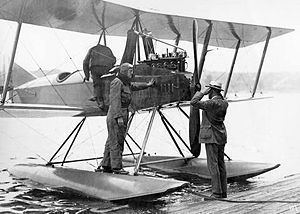Top speed 117 km/h Length 8.23 m | Wingspan 13 m First flight November 15, 1916 | |
 | ||
The Boeing Model 2, also referred to as the Boeing Model C and its derivatives were United States two-place training seaplanes, the first "all-Boeing" design and the company's first financial success.
Contents
Design and development
Pacific Aero-Products, the forerunner of the Boeing company, built its first all-original airplane, the Model C naval trainer. Early design work was started in late 1915, with the first wind tunnel tests being conducted at MIT's 4 ft wind tunnel in May 1916. Most of the design work was performed by James Foley, who had previously assisted George Conrad Westervelt in designing the Boeing Model 1. Westervelt, who had been reassigned to the East Coast in December 1915, consulted heavily on the design. Wong Tsu, a MIT graduate who was hired by Boeing in May, 1916, also contributed to the design, specifically lending his expertise in analysis of wind tunnel data. A total of 56 C-type trainers were built; 55 used twin pontoons. The Model C-1F had a single main pontoon and small auxiliary floats under each wing and was powered by a Curtiss OX-5 engine.
Operational history
The success of the Model C led to Boeing’s first military contract in April 1917 and prompted both its reincorporation as the Boeing Airplane Company and relocation from Lake Union, Washington to a former shipyard on the Duwamish River, also in Washington. The United States Navy bought 51 of the Model C trainers, including the C-1F, and the United States Army bought two landplane versions with side-by-side seating, designated the EA.
The final Model C was built for William Boeing and was called the C-700 (the last Navy plane had been Navy serial number 699). On March 3, 1919 Boeing and Eddie Hubbard flew the C-700 on the first international mail delivery, carrying 60 letters from Vancouver, British Columbia, Canada, to Seattle, Washington.
Variants
Operators
Specifications (Model 3)
Data from Boeing: History
General characteristics
Performance
